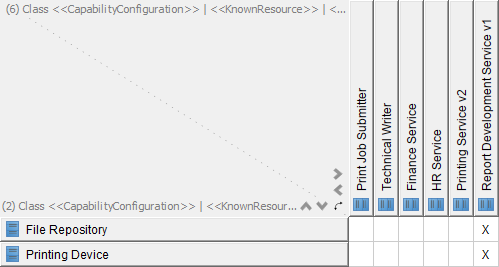A SvcV-3a enables a quick overview of all the system-to-service resource interactions specified in one or more SvcV-1 Services Context Description models. The SvcV-3a provides a tabular summary of the system and services interactions specified in the SvcV-1 Services Context Description for the Architectural Description. This model can be useful to support existing systems that are transitioning to provide services. The matrix format supports a rapid assessment of potential commonalities and redundancies (or, if fault-tolerance is desired, the lack of redundancies).
Usage
The intended usage of the SvcV-3a includes:
- Summarizing system and service resource interactions.
- Interface management.
- Comparing interoperability characteristics of solution options.
Product Description
The SvcV-1 concentrates on Service resources and their interactions, and these are summarized in a SvcV-3a or SvcV-3b.
The SvcV-3a is presented as a matrix, where the System and Services resources are listed in the rows and columns of the matrix, and each cell indicates an interaction between Systems and Services if one exists.
Creating a Systems-Service Matrix
To create a Systems-Service matrix:
- Click on Systems-Service Matrix in the Action Artifact area.
- This opens a chart with Systems (Resources) and Services (Resources) listed as rows and columns, respectively.
- Double click on a cell and select X to indicate an interaction between Systems and Services if one exists.

DoDAF in Visual Paradigm
The DoDAF is brought to you by Visual Paradigm, a full-featured development platform. Visual Paradigm provides an easy-to-use, model-driven DoDAF tool that supports the development of DoDAF 2.02 views and models. You can create integrated DoDAF products and generate architectural documents that facilitate organizations to efficiently coordinate enterprise architecture initiatives.